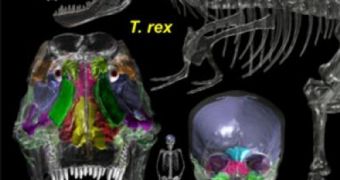Recent anthropological studies revealed that the head of large dinosaurs, such as Tyrannosaurus Rex, was more filled with sinuses than with brains, which seems to have prompted their remarkable ability of catching the prey, despite their bulky mass and constitution. CT scans of their heads revealed that the amount of sinusoidal bones totaled a larger amount of space than that occupied by the brain itself, researchers at the Ohio University note. "I've been looking at sinuses for a long time, and indeed people would kid me about studying nothing – looking at the empty spaces in the skull. But what's emerged is that these air spaces have certain properties and functions," says researcher Lawrence Witmer, who is a Chang Professor of Paleontology at the university's College of Osteopathic Medicine. He notes that the large cavity holes that he and co-researcher Ryan Ridgely found in the heads of large reptiles were most likely used for smell.
Witmer says that the large amount of sinuses must have undoubtedly meant that the weight of the head was far lower, proportionally speaking, than that of the body. This "light-headedness" was most likely the key to their keen sense of smell and their ability to move such a large head so fast. Paleontologists hypothesize that this feature may have also made it possible for dinosaurs like the T. Rex to eat very large prey, such as other dinosaurs.
Considering the fact that a "full" T. Rex head would have weighed as much as 1,100 pounds (550 kilograms), it stands to reason that the strain placed on the animal's spinal cord should have accounted for numerous collapsed spine cases, whereas researchers failed to come by one.
"Not only do these guys have nasal cavities like crazy straws, they also have highly vascular snouts. The nasal passages run right next to large blood vessels, and so there's the potential for heat transfer. As the animal breathes in, the air passed over the moist surfaces and cooled the blood, and the blood simultaneously warmed the inspired air. These are the same kinds of physiological mechanisms we find all the time in warm-blooded animals today," the researcher concludes.

 14 DAY TRIAL //
14 DAY TRIAL //